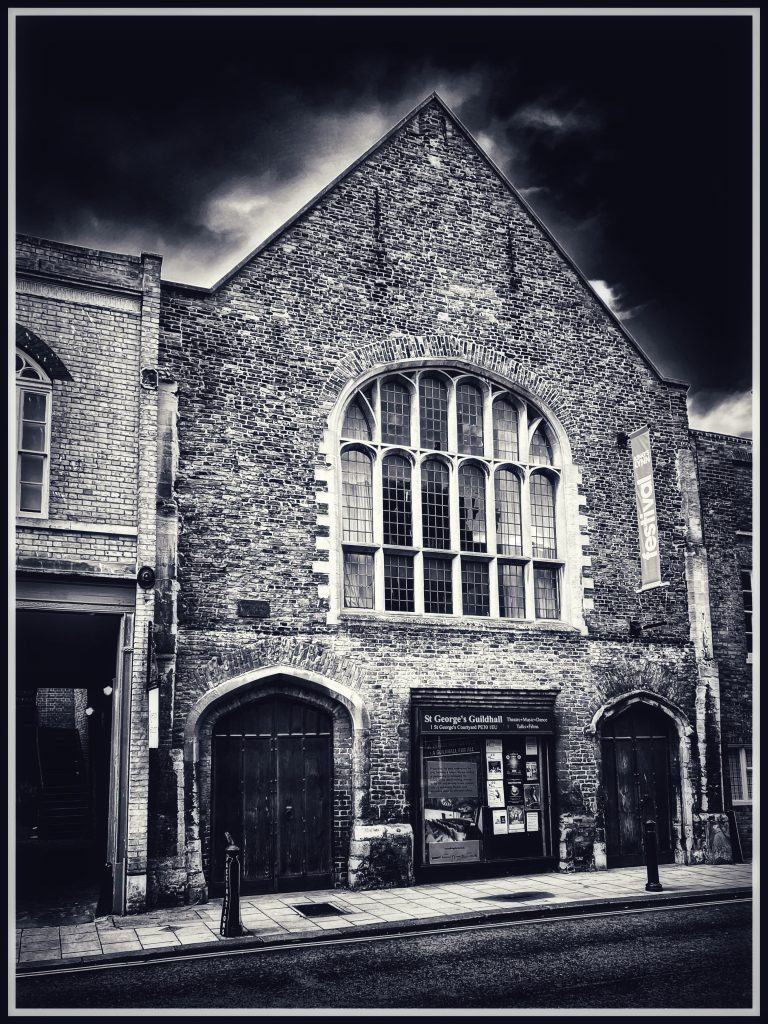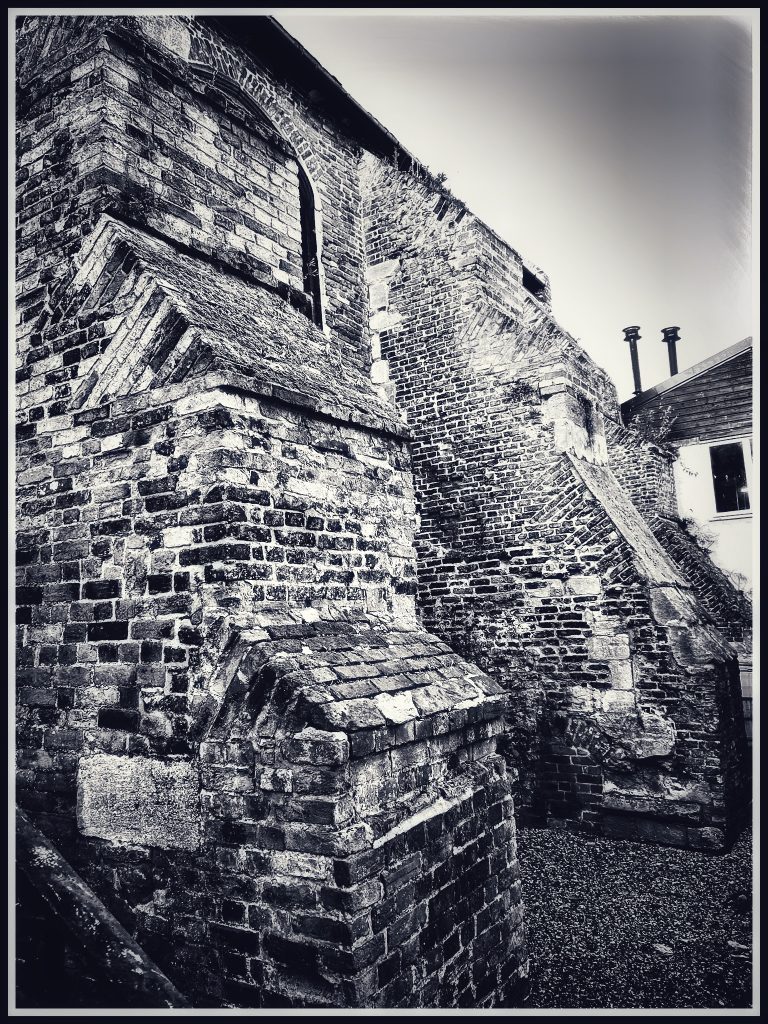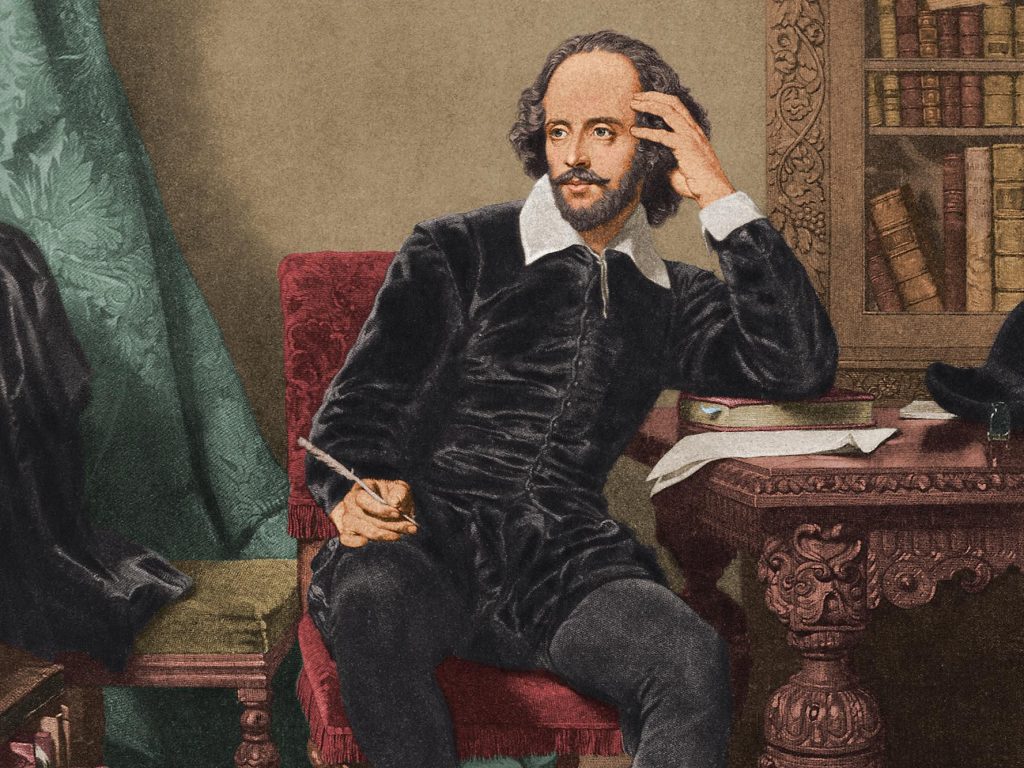The Buttresses, the Extended Building, the Bard, and the Button Factory

Photo © James Rye 2022
The Guildhall of St George in King’s Lynn is a Grade 1 listed building now owned by the National Trust. It is the oldest and largest complete, intact medieval Guildhall in England. It is larger than the Trinity Guildhall in the town, as that hall was slightly curtailed when an Assembly Room was added in the 1760s. The Guildhall in York can claim to be larger, but that suffered damage and restoration as a result of the Second World War. St George’s is complete and intact.
St George’s Guildhall: The Buttresses
By the end of the fourteenth century Lynn had many guilds, though the Guild of the Holy and Undivided Trinity, and the Guild of St George were the largest in the town. We know that by 1376 the St George’s had acquired land by the river to build the hall, and this was completed by 1428. Buttresses on the north side were added around 1500.

Photo © Simon Bell 2022
St George’s Guildhall: The Extended Building
The undercroft wine cellar was built in the late C17th. This was built from underneath the hall to give access to the river bank. As the nearside bank of the river moved towards the other bank, warehouses were just added to the length of the building at the back, and the undercroft was also extended underneath them. The result was that the undercroft is now the longest continuous building in King’s Lynn.
St George’s Guildhall: The Bard and Others

St George’s Guildhall has a long history of providing theatrical entertainment. The first recorded play was a nativity play in January 1445 before the Guild Feast. In the following years, until 1546, the Guild staged various theatrical events and a St George’s Day procession. After the Dissolution it was used by companies of Players – the Queen’s Players were here seven times between 1585 and 1595. We know that when the London theatres were closed because of the plague, the Earl of Pembroke’s Men performed on the King’s Lynn Guildhall stage in 1593. And William Shakespeare was writing for and performing with the Earl of Pembroke’s men at that time.
See also The Cry, The Murder, Lynn and the Bard.
Players continued to use the Guildhall at the start of the seventeenth century until the Commonwealth banned such performances. After the Restoration in 1660 various Norwich theatre companies leased it during the annual February Mart season, and continued to do so in the 18th century. In 1776 the Mayor of Lynn commissioned Thomas Sharpe to build a playhouse inside the Guildhall. The editor of the Cambridge Chronicle noted the problem of rowdy audiences, due to ‘irregular persons mixing with their superiors’.
St George’s Guildhall: The Button Factory and Others
Although Henry VIII dissolved the monasteries in 1537, it was his son, Edward VI who dissolved the Guilds and Chantries eleven years later (see Lynn Lost A Chantry). The Guildhall became the property of the King’s Lynn Town Corporation who owned it until 1814.
In addition to being a theatre, the hall has had a variety of uses. Like another famous King’s Lynn building, The Red Mount, the Guildhall served as a gunpowder store around the time of the Siege of King’s Lynn during English Civil War in the 1640s. In 1704 there was an unsuccessful attempt to use the building as a Button Factory for the unemployed. It has also served as a Public Meeting Hall, a Court House, a Merchants’ Exchange, and a French School.
In 1826 a Lynn merchant family (Everards) used the building as a warehouse. The Everards sold the hall in 1920 to G.M. Bridges and Son Ltd., internationally renowned scenic artists who held Royal Warrants for their work on outdoor theatre sets at Sandringham.
By 1945 the building was derelict and in danger of being demolished. It was purchased by Alexander Penrose and in 1950 was converted into an Arts Centre. This was opened by the Queen Mother in 1951 for the First King’s Lynn Festival on 24 July.
In 2019 the National Trust, the Borough Council and the newly formed Shakespeare’s Guildhall Trust began discussions on the way forward to preserve, expand and enhance the theatrical heritage.
© James Rye 2022
See also The Cry, The Murder, Lynn and the Bard.

[…] Thomas Heywood was as an English actor and playwright and in 1612 published his memoirs (An Apology for Actors). In the book he gives a vivid account of an incident that took place in a theatre in King’s Lynn. Although the the guildhalls of the Holy Trinity and of Corpus Christie were known to have occasional theatrical performances, they most frequently took place at St George’s Guildhall. […]
[…] See also St George’s Guildhall. […]